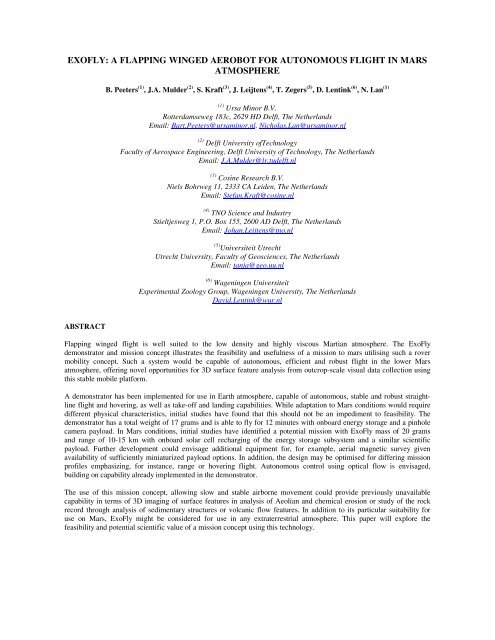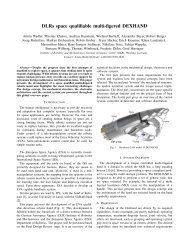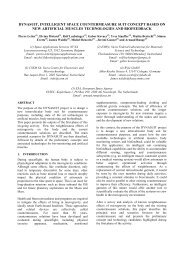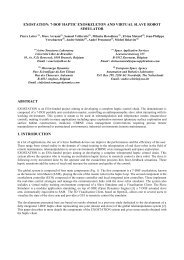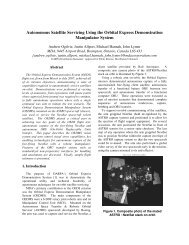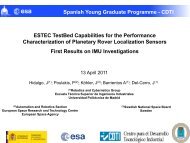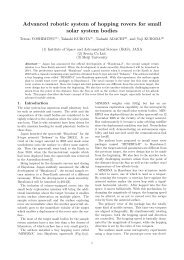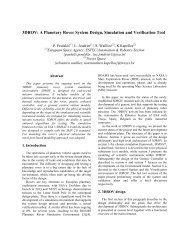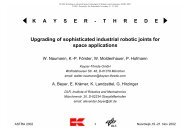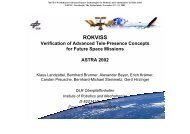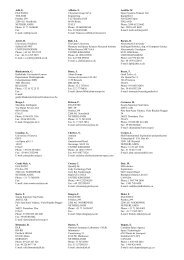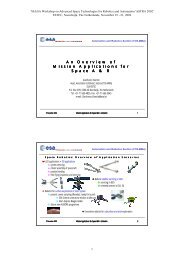EXOFLY: A FLAPPING WINGED AEROBOT FOR ... - Robotics - ESA
EXOFLY: A FLAPPING WINGED AEROBOT FOR ... - Robotics - ESA
EXOFLY: A FLAPPING WINGED AEROBOT FOR ... - Robotics - ESA
You also want an ePaper? Increase the reach of your titles
YUMPU automatically turns print PDFs into web optimized ePapers that Google loves.
<strong>EXOFLY</strong>: A <strong>FLAPPING</strong> <strong>WINGED</strong> <strong>AEROBOT</strong> <strong>FOR</strong> AUTONOMOUS FLIGHT IN MARS<br />
ATMOSPHERE<br />
ABSTRACT<br />
B. Peeters (1) , J.A. Mulder (2) , S. Kraft (3) , J. Leijtens (4) , T. Zegers (5) , D. Lentink (6) , N. Lan (1)<br />
(1) Ursa Minor B.V.<br />
Rotterdamseweg 183c, 2629 HD Delft, The Netherlands<br />
Email: Bart.Peeters@ursaminor.nl, Nicholas.Lan@ursaminor.nl<br />
(2) Delft University ofTechnology<br />
Faculty of Aerospace Engineering, Delft University of Technology, The Netherlands<br />
Email: J.A.Mulder@lr.tudelft.nl<br />
(3) Cosine Research B.V.<br />
Niels Bohrweg 11, 2333 CA Leiden, The Netherlands<br />
Email: Stefan.Kraft@cosine.nl<br />
(4) TNO Science and Industry<br />
Stieltjesweg 1, P.O. Box 155, 2600 AD Delft, The Netherlands<br />
Email: Johan.Leijtens@tno.nl<br />
(5) Universiteit Utrecht<br />
Utrecht University, Faculty of Geosciences, The Netherlands<br />
Email: tanja@geo.uu.nl<br />
(6) Wageningen Universiteit<br />
Experimental Zoology Group, Wageningen University, The Netherlands<br />
David.Lentink@wur.nl<br />
Flapping winged flight is well suited to the low density and highly viscous Martian atmosphere. The ExoFly<br />
demonstrator and mission concept illustrates the feasibility and usefulness of a mission to mars utilising such a rover<br />
mobility concept. Such a system would be capable of autonomous, efficient and robust flight in the lower Mars<br />
atmosphere, offering novel opportunities for 3D surface feature analysis from outcrop-scale visual data collection using<br />
this stable mobile platform.<br />
A demonstrator has been implemented for use in Earth atmosphere, capable of autonomous, stable and robust straightline<br />
flight and hovering, as well as take-off and landing capabilities. While adaptation to Mars conditions would require<br />
different physical characteristics, initial studies have found that this should not be an impediment to feasibility. The<br />
demonstrator has a total weight of 17 grams and is able to fly for 12 minutes with onboard energy storage and a pinhole<br />
camera payload. In Mars conditions, initial studies have identified a potential mission with ExoFly mass of 20 grams<br />
and range of 10-15 km with onboard solar cell recharging of the energy storage subsystem and a similar scientific<br />
payload. Further development could envisage additional equipment for, for example, aerial magnetic survey given<br />
availability of sufficiently miniaturized payload options. In addition, the design may be optimised for differing mission<br />
profiles emphasizing, for instance, range or hovering flight. Autonomous control using optical flow is envisaged,<br />
building on capability already implemented in the demonstrator.<br />
The use of this mission concept, allowing slow and stable airborne movement could provide previously unavailable<br />
capability in terms of 3D imaging of surface features in analysis of Aeolian and chemical erosion or study of the rock<br />
record through analysis of sedimentary structures or volcanic flow features. In addition to its particular suitability for<br />
use on Mars, ExoFly might be considered for use in any extraterrestrial atmosphere. This paper will explore the<br />
feasibility and potential scientific value of a mission concept using this technology.
BACKGROUND<br />
Flapping winged flight is used on Earth at mm to cm scales for flight by many animals with attractive capabilities in<br />
areas such as efficiency and agility. In recent years, research into flapping winged flight has found that performance of<br />
such systems is highly dependent on the Reynolds number regime in which the system is operating due to the<br />
importance of vortex generation and interaction in generating lift with flapping wings. Systems using flapping winged<br />
flight may operate in equivalent Reynolds number regimes to those of small insects but at larger scale in Martian<br />
atmosphere due to its low density and high viscosity. Preliminary assessments have also been made for use on other<br />
bodies in the solar system with atmospheres, but extrapolation for use on Mars is focused on as the most promising case<br />
in this work. Combined with the lower Martian gravity, it has been suggested that flapping winged rovers may provide<br />
an attractive solution for the provision of useful aerial exploration vehicles on Mars, particularly in light of the<br />
drawbacks inherent to other flight strategies on Mars [6] and the potential usefulness of aerial science platforms in<br />
general. At micro air vehicle (MAV) scales, fixed wing vehicles must translate through Martian atmosphere more<br />
quickly to generate adequate lift, making observation from such platforms more difficult and making landing and takeoff<br />
likely to be unfeasible. Propellers on such vehicles as well as rotor vehicles must generally rotate faster and must<br />
consider the lowered sound speed in Mars atmosphere. Design must therefore potentially account for operation at high<br />
Mach number. Balloons have been considered for use in Mars atmosphere but designs generally call for operation at<br />
relatively high altitude.<br />
The development of ExoFly concepts for exploration missions has stemmed in large part from the successful DelFly<br />
developments of Delft University, demonstrating the terrestrial feasibility of this system with good potential for<br />
extrapolation to Mars environment. Development of DelFly I began in 2004/5 and has evolved to produce DelFly II and<br />
DelFly micro prototypes, showing promising capability in a number of areas, with demonstrations to numerous<br />
international audiences. The foci of developments have included flight performance in terms of stability and agility,<br />
electronics, vision based awareness software and further miniaturisation. Further information and media regarding<br />
DelFly development is available online [8]. A DelFly prototype is shown in Figure 1.<br />
Figure 1: A DelFly demonstrator viewed from the front (left) and in flight (right)<br />
An implemented DelFly II demonstrator has approximately the following characteristics, dependent on particular<br />
implementations: -<br />
• Wingspan – 300 mm<br />
• Length – 300 mm<br />
• Mass – 15 g<br />
• Flying speed – Hovering to 30 km h -1<br />
• Flying Time - 15 min horizontal, 8 min hovering<br />
• Wing Material - Mylar foil<br />
• Structure – Carbon fibre tubes<br />
• Motor – 2 g pager motor<br />
• Camera – 2 g pinhole camera
• Energy storage – 3 g Li Polymer cell<br />
• Actuators – magnetic servos<br />
• Base station - 3GHz PC<br />
• Software - C++ including vision based feedback control for rotational stability<br />
The demonstrator is already capable of agile flight, take-off and landing by human operators requiring minimal training.<br />
Autonomous flight based on vision-based control using images from the camera payload is a goal of development.<br />
Vision based rotational stability control has already been implemented to aid human control of the system. The system<br />
is scalable with aerodynamic performance largely dependent on Reynolds number regime. For instance the DelFly<br />
micro demonstrator is already operational with maximum dimension of 10 cm and camera payload with a mass of 3 g,<br />
albeit limited to straight-line flight. Research into the DelFly aerodynamics are the subject of ongoing research [3] and<br />
initial calculations have estimated that, for a first iteration at DelFly II scale for example, the system would be able to<br />
operate in Mars atmosphere with a simple doubling of flapping frequency. Further, a system of this scale is deemed to<br />
be a reasonable base case for the assessment of a feasible system for Mars, given its existing flight and payload<br />
capabilities. This paper qualitatively explores the potential feasibility of this system, focusing on identification of any<br />
showstopping or particularly challenging aspects.<br />
EXPLORATION RELEVANCE<br />
In comparison to Earth and Venus, while similarities in formation and orbit suggest that Mars has similar early history<br />
to these other planets, Mars froze tectonically at a relatively early stage – probably between 4.2 and 3.8 Ga. Study of the<br />
early geology of Earth, and therefore the early evolution of life, is hampered by this difference in that rocks from its<br />
early history have been heavily altered or deformed by tectonic recycling. On Mars, on the other hand, information that<br />
may be applied to the study of the first billion years of evolution of all three planets is still readily available in rock near<br />
the surface [1][4][7].<br />
ExoFly offers a platform capable in the Mars environment of slow flight, hovering, landing and take-off. Given this as<br />
yet unexploited capability, the scientific opportunities that would be provided by such a platform are only beginning to<br />
be explored [4]. One of the most important is the opportunity to provide observations of outcrop scale observations<br />
from a mobile platform, and in the case of ExoFly imaging used in the first instance for navigation may also be used for<br />
such observations. Mobility that might be offered by such a platform would allow 3D analysis of imaged surface<br />
features currently unavailable from orbital or ground rover images due to inadequate resolution, atmospheric haze or<br />
limited viewing angles. For accurate interpretation, continuous regional context information level (several km) at<br />
outcrop scale (mm to m) and in 3D is important in combination with detailed geological measurements as would be<br />
performed by a conventional extraterrestrial rover. As such, ExoFly observations may be perceived as being synergistic<br />
with geological payload provided by other mission elements such as a ground rover, as well as combination with orbital<br />
observations. Such an observation platform can be compared to contextual observations that would be made by a field<br />
geologist in analysis of both environmental conditions (such as wind and chemical erosion) and past environmental<br />
conditions through geological study of the rock record (through, for example, study of sedimentary structures, volcanic<br />
flow features indicative of water depth and particle size in fans and deltas). The potential use of ExoFlies in such an<br />
architecture in terms of such Martian geological study has been discussed in the context of the proposed Mars Origins<br />
mission a precursor for potential Mars Sample Return missions [2][5]. In addition, significant geological interest has<br />
been identified in the use of 3D observations provided by ExoFly for the production of digital terrain models and<br />
images that may be combined to develop a virtual geological environment as a powerful tool for geological study [4].<br />
For a generic platform with locomotion characteristics similar to those of the ExoFly, additional measurements could<br />
take advantage of the opportunities for observation. Most importantly, aerial magnetic survey at low altitude would<br />
allow study of the true pattern of remnant magnetization of early Martian terrains. Similarly to the study of the magnetic<br />
anomaly pattern on the Earth’s oceanic crust, this could provide breakthroughs in our understanding of early Martian<br />
crustal dynamics.<br />
Additional parameters may be identified that would be interesting for measurement from an in situ aerial platform, so<br />
that in summary the following list of parameters may be summarised when considering payloads for such a vehicle: -<br />
• 3D outcrop scale observation at outcrop scale<br />
• Magnetic, regional Magnetic anomaly map<br />
• Temperature
• Pressure<br />
• Chemical composition of atmosphere<br />
• IR imaging<br />
MISSION CONCEPTS<br />
Baseline Architecture<br />
The high level architecture incorporating a single ExoFly of the Mars Origins proposal to <strong>ESA</strong> [5][2] is presented as a<br />
baseline. The basic architecture is shown in Figure 2 with communication relevant to ExoFly illustrated.<br />
Figure 2: Baseline architecture including ExoFly based on Mars Origins mission proposal. Communications<br />
traffic is described per uplink/downlink segment.<br />
Principle space segment elements are the orbiter, a mobile rover and an ExoFly. The ExoFly is intended to provide<br />
contextual geographical observations for detailed analysis performed by the rover as described in the previous section.<br />
In addition, mission objectives include scouting terrain to aid in path planning for the rover and initial visual inspection<br />
of the rover. Initial calculations gave the following characteristics estimates for the ExoFly in this context. Deployment<br />
of the ExoFly was envisaged to be achieved from its stored configuration onboard the rover, where stored volume of the<br />
ExoFly has been minimised through a stored configuration with folded wings.<br />
• Mass: < 40 g<br />
• Deployed volume: 50 cm x 50 cm<br />
• Power requirement including payload: 10W (hovering) 5W (horizontal flight)<br />
• Range: 4 km<br />
• OBDH: control, basic navigation, basic image processing, communications control
• Payload: video camera<br />
• Horizontal velocity: hovering to 70 km h -1<br />
• Altitude: < 500 m<br />
• Payload: pinhole camera (for both navigation and science), magnetometer, thermometer<br />
Charging of the battery will be achieved with solar cells attached to the tail, with take off and landing capability of the<br />
ExoFly allowing charging cycles while the ExoFly is on the ground. Command and control processing is performed on<br />
the rover so that continuous communication with the rover is assumed, in this case, requiring constant line-of-sight.<br />
Other Architectural Choices<br />
In terms of integration into a mission architecture, a number of other options might be considered for use of ExoFly.<br />
Major areas are described below.<br />
Number of ExoFlies<br />
Considering the use of ExoFly purely as an observation platform, initial calculations suggest that a single vehicle would<br />
be feasible for a mass of a few tens of grams. Therefore, missions can be envisaged using multiple ExoFlies to enable<br />
increased observation coverage for ExoFlies of a given lifetime, simultaneous distributed measurements and<br />
redundancy.<br />
Communications<br />
Communications links may be envisaged between the ExoFly and a ground rover, high altitude balloon or orbiter. In<br />
general communications is considered between ExoFly and a rover to minimise communications requirements for all<br />
elements. The major source of bandwidth from ExoFly communications will be downlink video data transmitted from<br />
ExoFly for input for control instructions from a remote processor and for geological imaging. Optical flow control for<br />
ExoFly will require lower quality visual data than that used for science, in general. Considering full flight control of<br />
ExoFly from a remote processor, initial calculations indicate a minimum required data rate for downlink video of<br />
around 40 kbps. A scenario for science quality image transmission may be imagined such that higher resolution images<br />
are transmitted at a rate relating to the translational speed of the ExoFly relative to the surface under study for instance,<br />
to reduce bandwidth. Compression of such images onboard the ExoFly might also be considered while also accounting<br />
for mass and power requirements of the associated processing.<br />
The Mars origin concept assumes that the ExoFly is always in line-of-sight of the rover such that processing of visual<br />
data for autonomy may be done on the rover, thereby minimising processing requirements on the ExoFly itself.<br />
However, interest in observations of rock inaccessible to rovers or orbiters, as well as the potential for loss of line of<br />
sight to the rover through gusts of wind, for example, imply a need for a degree of autonomy onboard the ExoFly itself.<br />
For example, much geological information is contained on vertical rock surfaces where ExoFly observations might well<br />
be out of line of sight of an associated rover. In such an architecture ExoFly would need to be able to autonomously<br />
store and execute a flight and observation plan as well as store collected data.<br />
Power<br />
It is proposed that power be supplied by a rechargeable battery, with solar cells to be mounted on the ExoFly tail to<br />
allow independence from other mission elements. However, tail mounting presents design issues in terms of pointing<br />
and exposure to sunlight since current DelFly designs use the tail as a landing platform. It might also be conceived that<br />
charging could be achieved through interaction with a rover base station. Alternatively, single use ExoFlies might be<br />
considered. Removing recharging capability would simplify the system while mission coverage requirements might<br />
then be fulfilled through the use of multiple ExoFlies. Consideration of single use ExoFlies would lessen various<br />
requirements on a redesigned ExoFly including those regarding robustness, landing and takeoff.<br />
Deployment<br />
Several possible high level deployment schemes have been identified based on other elements in the mission<br />
architecture such as a ground based rover/lander, high-altitude balloon or orbiter. In the case of storage followed by<br />
deployment from a ground based rover, careful design will be required to minimise the risk to the overall mission in
case of ExoFly failure. Impingement on rover instrumentation or mobility by a failed ExoFly deployment must be<br />
avoided, for instance. Strategies considered focus on ensuring failures occur at a distance from the rover, including<br />
impulsive ejection of inert ExoFly from the rover and movement of rover away from deployed inert ExoFlies before<br />
activation and takeoff.<br />
Further Redesign Issues<br />
While the DelFly already has considerable capability in the terrestrial environment, significant development is required<br />
for remote use on Mars. Considering primarily the baseline architecture described above, the following critical issues<br />
may be described.<br />
Power generation and storage is challenging, firstly in terms of the low temperature environment to be mitigated. Low<br />
mass is critical to feasibility of the locomotion of the vehicle, such that strategies used by conventional rovers such as<br />
insulation and active heating to protect the batteries may be unattractive for use in this case. While a penalty in terms of<br />
energy density would be incurred, use of supercapacitors for energy storage has been suggested due for resistance to the<br />
low temperatures to be encountered. In addition, recharging strategy of the batteries, with integration of solar cells into<br />
the tail, must be considered.<br />
While some autonomous control has already been implemented to augment direct human control of the DelFly<br />
demonstrators, complete flight, landing and takeoff autonomy is ongoing. In addition, it is likely that at least basic<br />
autonomy will be required onboard the ExoFly, rather than on the rover, to account for periods out of line-of-sight of<br />
the rover and to reduce communications requirements between the two.<br />
Localisation of the ExoFly will be critical to the usefulness of scientific observations if they are to be used in synergy<br />
with those of the rover. Vision based navigation based on recorded images are being considered for use as a navigation<br />
strategy but potential feasibility for differing mission types and accuracy are still to be fully assessed.<br />
Materials and parts used currently are commercially available and therefore suitability for use in space must be<br />
considered, with replacement if necessary. Lubrication of joints has also been identified as a challenging issue. For<br />
example, lubricants on the current Spirit and Opportunity rovers require active heating to retain adequate<br />
characteristics. A miniaturised magnetometer that may be further developed for use onboard ExoFly has already been<br />
identified [11].<br />
The relatively high frequency motor used to drive the wings has been identified as potentially causing interference to<br />
subsystems and payload, in particular the potential magnetometer payload and camera. As before, on this lightweight<br />
system opportunities for electromagnetic shielding or other direct methods of mitigation will be limited. Furthermore,<br />
flapping motion introduces instability to the images produced by the onboard camera. The impact of this source of error<br />
must be assessed for both visual navigation and scientific imaging. Mitigation strategies might include correction of<br />
images in software or implementation of error tolerant navigation.<br />
Exposure to the Mars environment must be mitigated with enhanced robustness and operation in the outside<br />
environment must be considered carefully. The current DelFly prototypes are relatively fragile and require frequent<br />
small repairs to function. Outdoor tests have been performed successfully but the system is highly sensitive to wind.<br />
Mitigation strategies might include operation only when in low wind conditions, or scheduling flights when wind is in<br />
the desired direction of motion. The ExoFly will also be vulnerable to high winds when on the ground. Possible<br />
mitigation may involve landing only in sheltered areas or integration of an anchoring system.<br />
Further aerodynamic study and optimisation for the Mars environment of the wings must be performed in terms of<br />
shape, materials, configuration and flapping motion. Tests are planned using environmental chambers at the University<br />
of Wageningen.<br />
It will be desirable for the system to be deployable to minimise stowed volume although this will introduce additional<br />
failure points and complexity into the design, as well as a requirement for some kind of actuation for deployment.<br />
Stowed configurations will likely involve folding of the wings.<br />
In summary, as yet no showstopping issues have yet been identified in use of the ExoFly concept as part of a Mars<br />
exploration mission architecture. It has been proposed that development of this technology may play an important role
in study of the early development of Mars and by analogy Earth, such that a mission including ExoFly may be both<br />
scientifically rewarding and evocative [9][10].<br />
CONCLUSIONS<br />
The ExoFly concept has been introduced in terms of its potential use in future robotic exploration and on Mars in<br />
particular. Its potential novelty and usefulness in terms of performance as a geological science platform has been<br />
described and compared with alternatives. It is thereby proposed that development of this platform for use in synergy<br />
with a rover or lander on Mars could provide part of a powerful architecture for performance of novel science. Other<br />
potential scenarios for use of ExoFly on Mars are explored along with issues involved in redesign of the current DelFly<br />
prototype for use in such roles. So far, no showstopping issues have been identified, though areas where significant<br />
development is required have been described, as well as areas that will be particularly challenging to the system design.<br />
REFERENCES<br />
[1] Connerney, J.E.P., Acuna, M.H., Ness, N.F., Spohn, T., and Schubert, G., 2004, Mars crustal magnetism:<br />
Space Science Reviews, v. 111, p. 1-32.<br />
[2] Klingelhöfer, G., Westall, F., Zegers, T., Pullan, D., Mars Origins Mission, Lunar and Planetary Science<br />
XXXIX (2008), Mar 10-14, League City, Texas, 2008.<br />
[3] Lentink, D., Exploring the Biofluiddynamics of Swimming and Flight, PhD Thesis, Experimental Zoology<br />
Department, Wageningen University, 2008.<br />
[4] Zegers, T.E., Mulder, J.A., Remes, B., Berkouwer, W., Peeters, B., Lentink, D., Passchier, C., ExoFly: a<br />
flapping wing aerobot for planetary survey and exploration, Vol. 3, EPSC2008-A-00396, European Planetary<br />
Science Congress, September 21-26, Munster, 2008.<br />
[5] Westall, F., Klingelhöfer, G., Zegers, T., Pullan, D., Mars Origins Mission, Geophysical Research Abstracts,<br />
Vol. 10, EGU2008-A-04578, SRef-ID: 1607-7962/gra/EGU2008-A-04578, EGU General Assembly 2008.<br />
[6] Laan E., Wielders A., Eggers A., Burke J., ”Advances in planetary aerobots” IAC-04-Q.4.0 55 th International<br />
Astronautical Congress of the International Astronautical Federation, the International Academy of<br />
Astronautics, and the International Institute of Space Law, Vancouver, Canada, Oct. 4-8, 2004.<br />
[7] Bibring, J.-P., Y. Langevin, J. F., Mustard, F., Poulet, R., Arvidson, A., Gendrin, B., Gondet, N., Mangold, P.,<br />
Pinet, and F. Forget, (2006), Global mineralogical and aqueous Mars history derived from the OMEGA/Mars<br />
Express data, Science, 312, 400– 404.<br />
[8] The DelFly homepage, http://www.delfly.nl/, accessed 03/11/2008.<br />
[9] Fluttering robot could show Mars rovers the way, New Scientist, 30 September 2008,<br />
http://space.newscientist.com/article/mg19926756.100-fluttering-robot-could-show-mars-rovers-theway.html?feedId=online-news_rss20,<br />
accessed 03/11/2008.<br />
[10] ExoFly: Mars' first tourguide, engadget, Oct 3rd 2008, http://www.engadget.com/2008/10/03/exofly-marsfirst-tourguide/,<br />
accessed 03/11/2008.<br />
[11] K. Krogsgaard. Compact Vector Magnetometer for Pico Satellites. 17th Annual AIAA/USU Conference on<br />
Small Satellites, 2003.<br />
ACKNOWLEDGEMENTS<br />
The authors would like to thank Walter Berkouwer and the Delfly demo team for their support regarding the Delfly<br />
prototype and demonstration.


